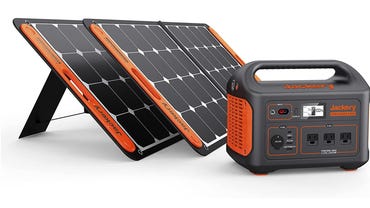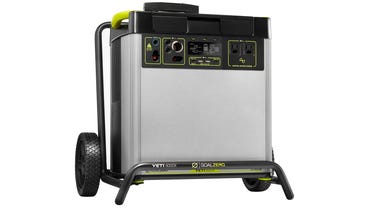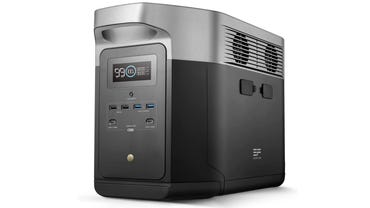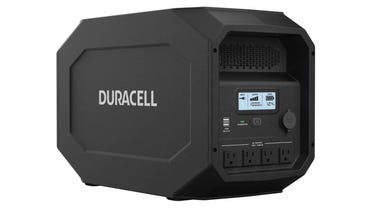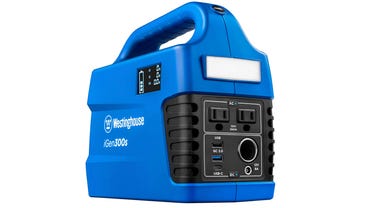Best portable power station 2022: Emergency power when you need it
A portable power station is an essential piece of equipment to keep important devices like medical equipment, radios, appliances, and smartphones charged and running during emergencies and power outages. Many power stations have both standard AC outlets and USB ports for powering multiple types of devices at once. Portable power stations have an advantage over traditional generators, in that they don't require gasoline, kerosene, or propane to run. This not only saves you money and time spent on engine maintenance, it makes battery backups much, much safer to use indoors.
Power stations also give you a wider range of power output options than traditional generators. If you just want to keep your phone charged and a radio running, there are handheld inverters available. But if you need to keep high-power items like CPAP or oxygen machines and even kitchen appliances running, you can purchase a power station that has an electrical output comparable to that of a traditional generator.
Also: Best extreme weather tech: Power outage gear
Portable power stations are also quieter than traditional generators, letting you hear important updates more easily, and feature push-button starts and instant-on abilities; no more struggling with pull-starts and warm-up cycles. If you want a more in-depth explanation of the differences between portable power stations and traditional generators, you can read our special feature, which covers everything from cost and energy needs to how weather and even earthquakes affect your emergency power options. You can also check out our list of the best home generators for whole-home emergency power.
Emergency power for essential equipment
The Jackery Solar Generator 1000 is designed to give you safe, reliable power in the event of an emergency. It has a 1000 watt output, meaning you can do everything from charging your phones and tablets to keeping a mini fridge running or setting up a space heater to stay warm during a winter storm. It features 3 standard AC outlets for plugging in things like lamps, heated blankets, and medical devices, 2 USB-C ports, and 2 USB Type-A ports for charging electronics.
The easy-to-read LCD display lets you quickly see how much power the generator has left, and you can purchase solar panels for more eco-friendly recharging; the solar panels are also great for steady power during summer storm outages. A one-button push start gives you instant electricity, and being battery powered means you don't have to worry about keeping the battery pack fueled up or venting harmful exhaust.
Also:
Power for the whole house
This home battery backup is designed for heavier duty use. It gives you an impressive 2,000 watt or 120 volt output, and features 7 different types of outlets for powering just about anything and everything in your home. Goal Zero claims that this electric generator can keep a standard refrigerator running for over 100 hours, a CPAP machine for over 90 hours, and lamps for almost 550 hours.
The generator itself has a compact form, but comes in at a hefty 106 pounds. Luckily, it's mounted on a wheeled trolley to make it easier to place where you need it. Along with standard AC outlets and USB ports, the Yeti 6000X has inputs for connecting Goal Zero solar panels. Attaching solar panels gives you quicker unit charging over wall outlets, and ensures that you can keep your generator in top working order during prolonged power outages.
Fast-charging power station
The Ecoflow Delta Max 2000 is one of the fastest charging home battery backups on the market. When charged over a standard wall outlet, you'll get up to 80 percent battery in just 65 minutes and a full charge in just under 2 hours. This makes it perfect for sudden emergencies like summer storms or winter weather; you can quickly top up the generator's battery while keeping an eye on news alerts. With a truly remarkable 5000 watt output, you can charge and power up to 15 devices at once, including refrigerators, CPAP machines, and even your electric or induction range!
Ecopower also claims that you can daisy-chain several Delta Max 2000 units together to create even more power for your home; and the companion app makes it easy to keep an eye on power levels and catch issues before they can become massive problems. Like other battery backups on the market, this model can be charged via solar panels for more eco-friendly power.
You can read more about the Ecoflow Delta Max 2000 in our in-depth review.
Compact battery backup
The Duracell PowerSource is a compact battery backup that's perfect for keeping on-hand during emergencies. It measures 20 x 9 x 13 inches, letting you tuck it away on a garage shelf or in a cabinet until it's needed, and the integrated carrying handles make it easy to place wherever you need power. You'll get 1800 watts of peak power, with 1440 watts continuous, so you can keep your phones charged, your fridge running, or your medical equipment powered on. You can even use it to power your sump pump in order to keep your basement from flooding during a power outage.
The one-touch instant on gives you immediate power so you can stay connected to news alerts and let family and friends know you are safe. It features 4 standard outlets, 2 USB ports, and a 12V port for powering any number of devices. You can also connect a solar panel for continuous charging or connect the unit to your car to use the vehicle's alternator to charge the battery backup.
Affordable backup power
The Westinghouse iGen300s is one of the more affordable options if you're shopping for a home battery backup. For under $300, you can get this 300 continuous watt electric generator to power essential equipment. It has both standard AC outlets and USB ports as well as an integrated flashlight for navigating dark areas or providing emergency illumination. The unit can be charged via a wall outlet or solar panel, giving you options for both intermittent and continuous power during emergencies.
Westinghouse claims this unit can power a CPAP machine for up to 23 hours, and can charge your smartphone to full up to 31 times. The integrated LCD screen gives you vital information at-a-glance: you can see battery capacity, charging status, temperature warnings, electrical input and output, and even monitor the USB ports so you can catch issues before they become dangerous problems.
Honorable mentions
Ryobi RYi300BG
Truly portable power
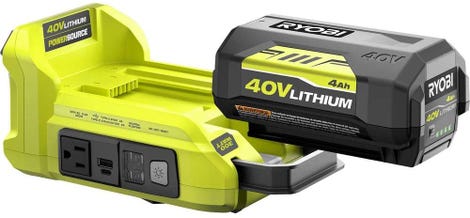
Amazon
Buy now at Amazon
Buy now at Home Depot
If your emergency power needs are very limited, or you just want something that's a bit easier to use when charging phones or running small electronics, the Ryobi 40V power inverter is an excellent option. This unit works with all 40V Ryobi batteries, making it easy to integrate into your existing toolbox or purchase extra batteries for. It features a USB-C and USB Type A port as well as a single standard AC outlet.
You can charge phones, power a radio to stay up-to-date on weather alerts, or run a heated blanket to stay warm during winter power outages. It produces 300 watts of continuous power, making it perfect for short-term energy or for electronics that don't need a lot of power. An indicator light on the side of the unit lets you know when the battery needs changed; run times will vary depending on the type of 40V battery you use. Ryobi suggests using their High Capacity 40V battery packs to maximize use.
Milwaukee MX FUEL Carry-On
Rugged emergency power
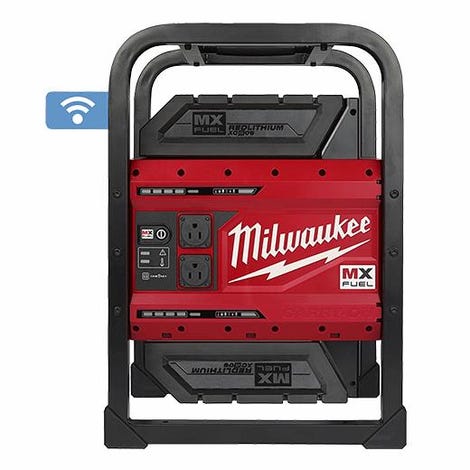
Home Depot
Buy now at Home Depot
This battery backup system is a great option for anyone who needs a unit that is built for durability as well as portability. The Carry-On features a metal roll cage to protect the body from falling objects and crushing force. The cage also keeps the system off the ground to prevent accidental damage from moisture.
The Carry-On works with all MX FUEL batteries, making it easy to integrate into your existing toolbox or purchase extra, dedicated batteries for. You can use just one battery for limited power electronics like radios and lamps or two batteries for extended run time and higher-consumption equipment like CPAP machines or even mini fridges. With 1800 watts of continuous power, and a peak of 3600 watts, you'll have more energy to keep your essential equipment running during power outages.
FAQ
What's the difference between a battery backup and a generator?
A generator is typically used to restore power to your entire home, or at least most of your home, for as long as you have fuel to power the generator. A battery backup doesn't have the same energy capacity, and is best used to keep essential equipment like CPAP machines, sump pumps, and space heaters running until power is restored. Battery backup systems also don't need kerosene, gasoline, or propane to run, making them much safer to use indoors and a bit more cost-efficient to run; this also means you don't have to worry about engine maintenance.
How long will a battery backup last?
That depends on the backup unit's power capacity and how many devices you have connected to it. Lower wattage units will only give you up to about 10 hours of emergency power, while higher wattage units may give you several days worth of electricity. Many newer battery backup systems allow for charging via solar panels, giving you continuous charging options during lengthy power outages.
How big of a battery backup do I need?
The best way to determine your emergency power needs is to make a definite list of devices you'd want to keep running during an outage. Do you just want to keep your phones charged and a radio powered on to hear weather alerts? You should opt for a low-wattage backup. Do you need to run medical equipment, standard appliances, or a pellet stove? It's better to invest in a much higher wattage backup system.
Once you have a list of devices, add up their voltage and wattage; that number is how much output your battery backup system should have, at minimum. It's better to have a backup that gives you a bit more juice than you need than one that struggles to keep up.

